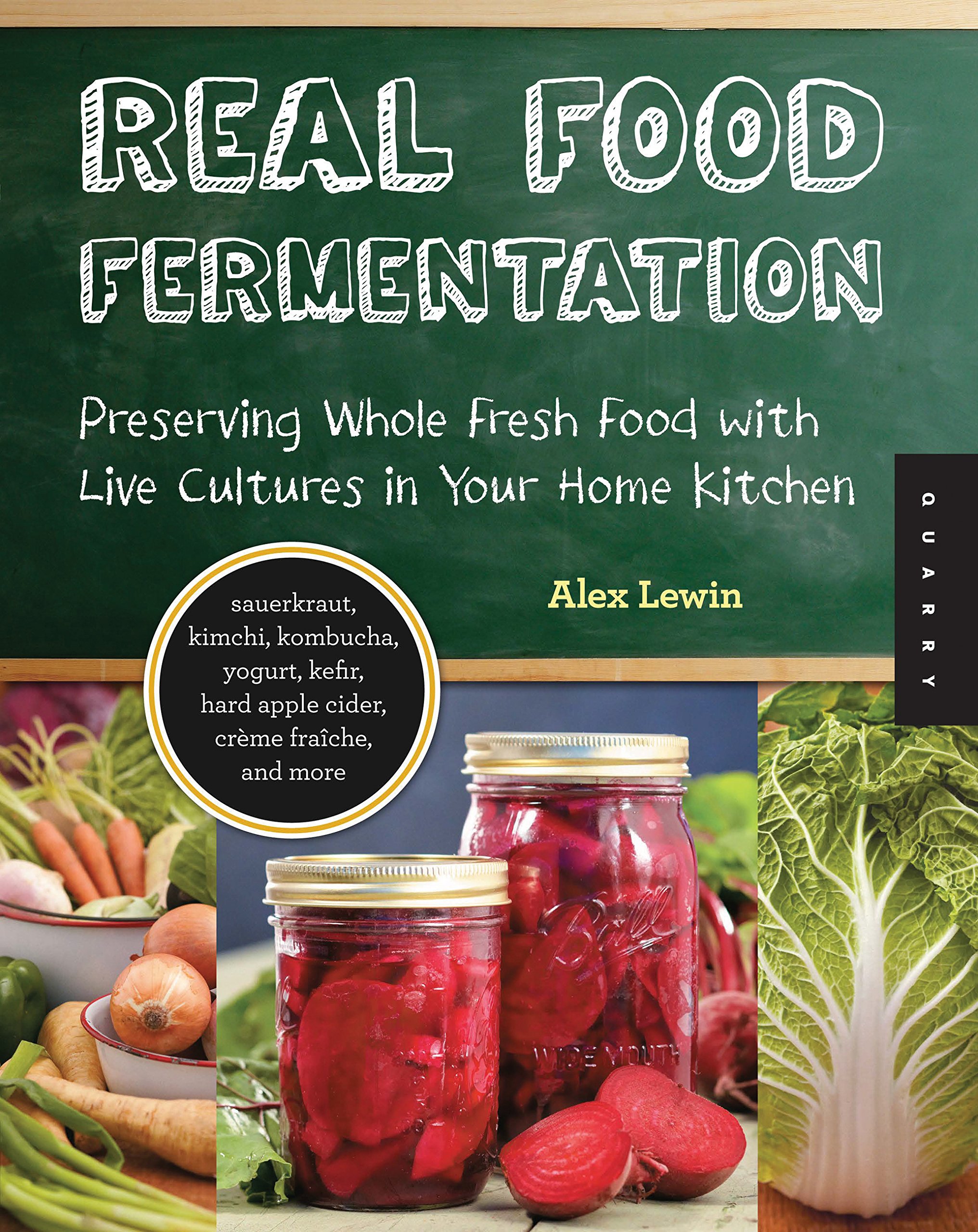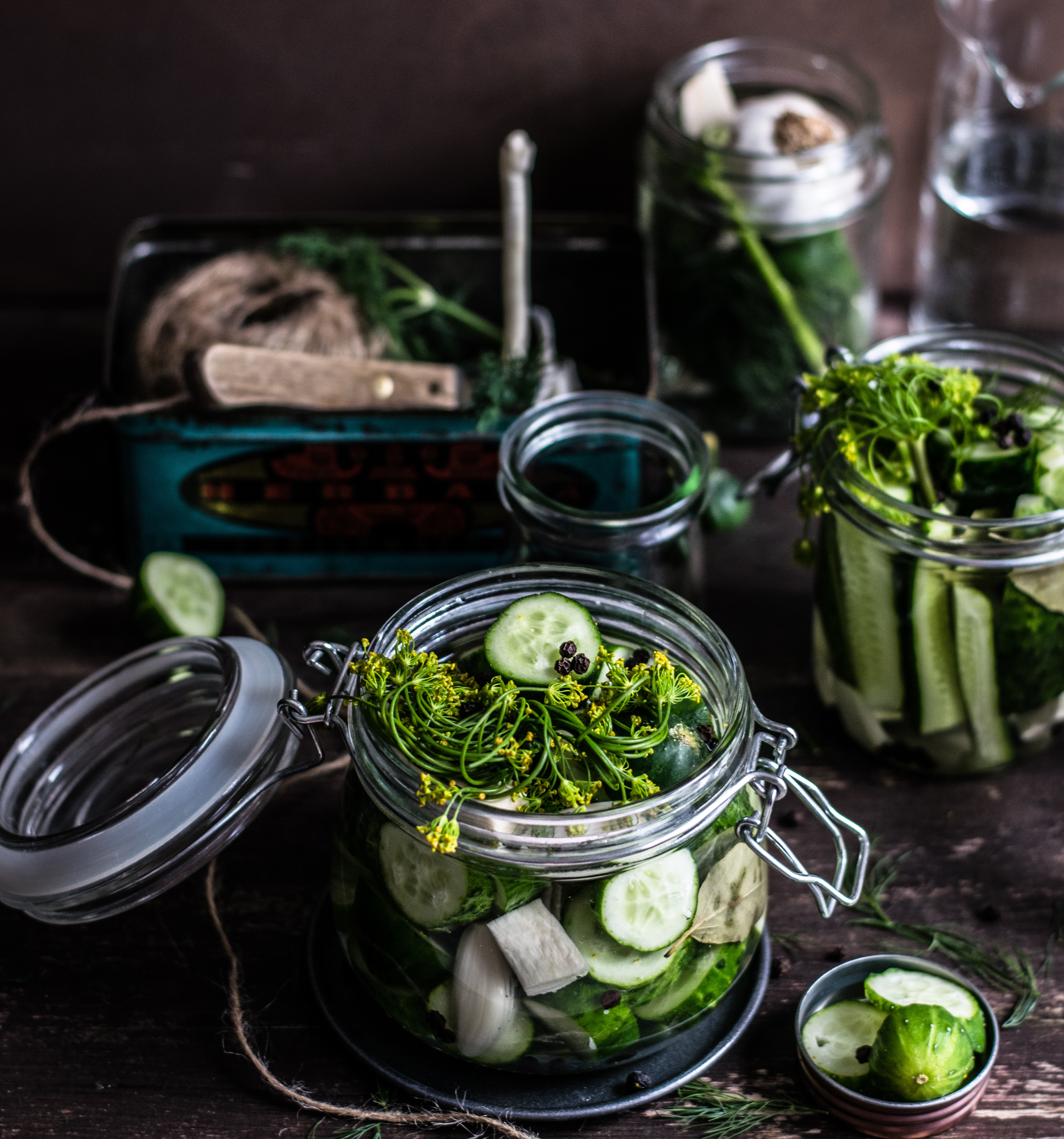Have you ever left a jug of milk on the counter for a few days? Maybe some veggies, or yogurt too? I live for fermented foods! Raw whole milk kefir, sauerkraut, kombucha, oh my! So why all the love, you ask? Fermented foods not only taste delicious, they are full of beneficial bacteria, enzymes, minerals, and more to keep your gut, immune system, and body strong. I always have some fermentation experiment going in my kitchen. Whether it be a cabinet of home brewed kombucha, jars of pickled beets and carrots or the strangest concoction of all: clumpy, lumpy fermenting sour milk. I like to think of my little kitchen as a science lab, full of odd (but very delicious) ferments.
With that, today we are up to something a little bit different on the blog. We will dive into the book Real Food Fermentation by Alex Lewin, and take a closer look at why and how these foods are so good for you. And at the end, I will share one of my favorite ferments!
 The book starts out with an overview of fermentation, a tried and true method of food preserving. In short, food preserving is simply “extending a food’s window of edibility” (pg. 18). It should come as no surprise that years ago, our ancestors did not have refrigeration and other simple conveniences to keep food fresh. So they often fermented it, rendering it edible for longer stretches of time.
The book starts out with an overview of fermentation, a tried and true method of food preserving. In short, food preserving is simply “extending a food’s window of edibility” (pg. 18). It should come as no surprise that years ago, our ancestors did not have refrigeration and other simple conveniences to keep food fresh. So they often fermented it, rendering it edible for longer stretches of time.
The process of fermentation appears simple, requiring only basic ingredients such as vegetables, a jar, a knife, and salt. Yet on a microscopic level, fermentation is actually quite complex. Fermentation works by harnessing the power of microorganisms such as bacteria, yeasts and mold to convert the sugars in foods into other compounds. In lacto-fermentation for example, lactobacillus strains of bacteria convert the sugars in fruits, vegetables and dairy into lactic acid—a natural preservative. If you’ve enjoyed pickles, kimchi, or sauerkraut, then you’ve experienced this intricate process first hand! Other ferments, like kefir and kombucha, use a mixture of microorganisms to do the job. If you have ever made your own raw kefir, you know how yeasty it smells after a few days!
Interestingly, fermentation is also helpful for boosting the nutritional value and digestibility of foods. The very microorganisms that are responsible for fermentation also help break down difficult-to-digest foods and make their minerals and vitamins easier to absorb.
What was once a craft necessary for basic survival, fermentation has re-emerged as a popular method for storing food in modern homes. The pay off, next to all the health and nourishing benefits, is food lasting for weeks or even months when it would normally only remain edible for days at a time. Take a look at raw milk: it is typically only fresh for about 7-10 days. Throw some kefir grains in it and ferment, and it is now delicious for an entire month! Vegetables are even more impressive with shelf lives of six months or more when properly stored.
When fermenting, it is essential to know your ingredients and strive to obtain the best options out there. This means ditching pesticide laden foods and buying organic. It also means taking into consideration details such as water quality. The chlorine present in municipal water supplies kills off the bacteria that are required for fermentation. Therefore it is best to use filtered water when making ferments, especially if you are on town/city water. Radiant Life has a number of different water purification systems ranging from basic to more comprehensive. Check them out here!
 All in all, fermenting foods is not only good for you, it is fun! It can be a very social activity where you connect with like-minded people. Every once in a while some friends and I will have a fermented foods party and all gather together at someone’s house to make big batches of pickles, krauts, and other delicious goodies. In that spirit, you will find an all-time favorite recipe of mine for Pineapple Turmeric (Mint) Kraut below.
All in all, fermenting foods is not only good for you, it is fun! It can be a very social activity where you connect with like-minded people. Every once in a while some friends and I will have a fermented foods party and all gather together at someone’s house to make big batches of pickles, krauts, and other delicious goodies. In that spirit, you will find an all-time favorite recipe of mine for Pineapple Turmeric (Mint) Kraut below.
For more tasty recipes, vibrant photos and fun facts, I definitely recommend Real Food Fermentation by Alex Lewin. It is a fantastic step-by-step guide that is well-suited for beginners, but also offers inspiration for more experienced fermenters too.
Pineapple Turmeric (Mint) Kraut
Ingredients:
2 heads of cabbage
2.5 cups of pineapple shredded up
1 Tbsp. turmeric powder or 2 Tbsps. fresh-chopped turmeric
3 Tbsps. Kosher Sea Salt
2 Tbsps. Ground up ginger
Optional mint leaves to your liking
Instructions:
- Rinse heads of cabbage well and discard any outer, wilted leaves. Save one large leaf for later.
- Cut cabbage heads into quarters and remove the core.
- Remove the head from the pineapple and slice off the skin. Cut in half lengthwise and remove the tough core.
- Shred the cabbage and pineapple down and put in a mixing bowl.
- Add salt and massage cabbage mixture for 10 minutes until it softens and releases liquid.
- Add turmeric, ginger, and mint as desired and toss to combine.
- Put the cabbage into fermentation jars and press down firmly with your hands, using all liquid released from the cabbage.
- Trim the extra cabbage leaf into a circle and place on top of the other kraut.
- Add fermentation weight to the top. You will want the cabbage to be completely submerged during the fermenting.
- Screw on an airtight lid and store at room temperature for one week away from direct sunlight.
- Once finished, transfer to other mason jars and store in the refrigerator for up to two months.
